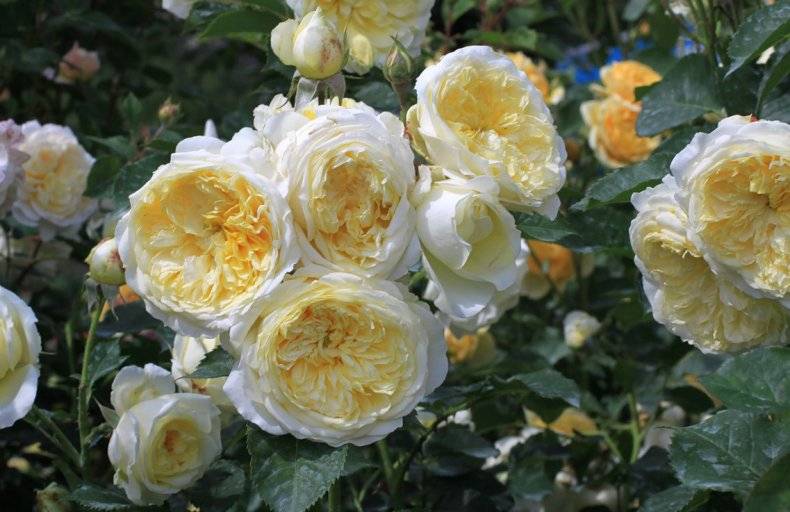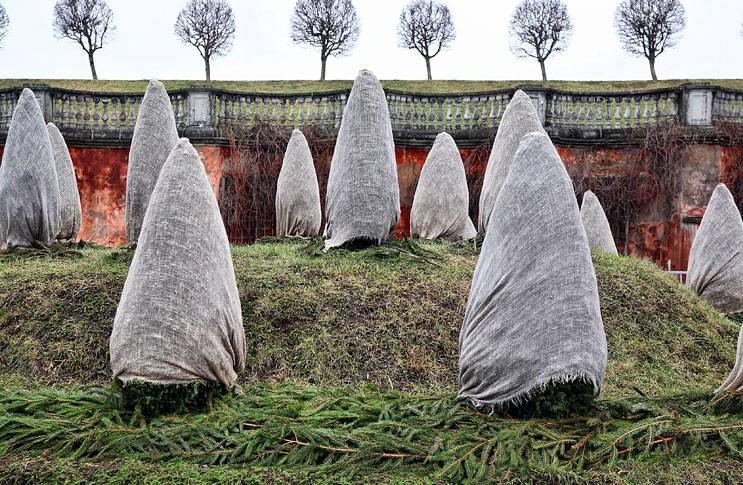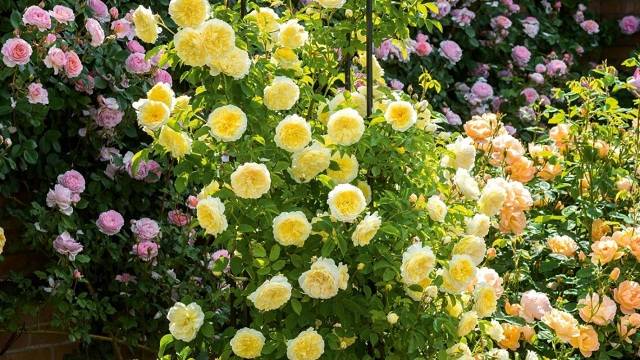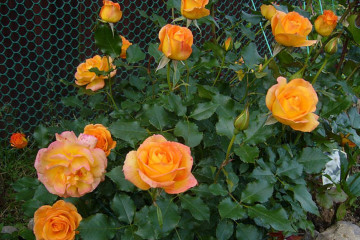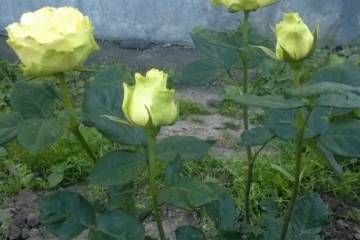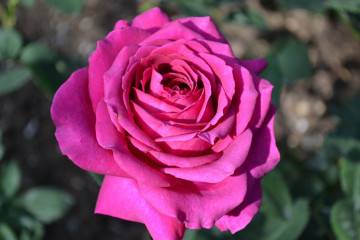Rose Pilgrim (The Pilgrim) - characteristics of varietal shrub
Content:
Rosa Pilgrim is the most beautiful representative of rose bushes with yellow flowers. The variety differs from many other English roses in the shape of the inflorescences, which outwardly look more like peonies than standard buds.
Rose Pilgrim (The Piligrim, Pilgrim, AUSwalker, Gartenarchitekt G? Nther Schulze) - what is this variety
The variety was bred by the English breeder D. Austin in 1991. Graham Tomas and Yellow Button varieties were crossed to breed a new rose.
Brief description and characteristics
Rose Ze Pilgrim is an unusual flower, which is evident from its description:
- the bush, provided that the shoots are on a support, reaches a height of about 3 m;
- the branches are standing. Pilgrim is a rose scrub;
- leaves are dark green, their surface is glossy;
- the flowers are soft, silky, their color is pale golden;
- the rosette has an ideal round shape, it is assembled from many small petals, from 100 to 150 pieces;
- the inner part of the petals is colored yellow, the outer side has a rich white color.
Advantages and disadvantages of the variety
Pilgrim is a successful variety that combines the best characteristics of rose bushes:
- the ability to develop in any climatic conditions;
- lush and long flowering, which lasts until the onset of cold weather;
- excellent decorative characteristics;
- persistent, strong aroma;
- the buds are evenly distributed over the bushes;
- endurance of the shadow.
The disadvantages include low frost resistance and exactingness in creating favorable growing conditions.
Growing a flower: how to plant it in open ground
To grow a Pilgrim, you need to choose high-quality seed and take a responsible approach to the selection of a suitable place for seedlings.
Planting is carried out only with seedlings in September - the first half of October.
Seat selection
Well-lit areas are suitable, without prolonged exposure to direct sunlight. You can not place a rose in lowlands where water stagnates and cold air.
How to prepare the soil and flower for planting
The soil should be slightly moistened, but not heavily flooded, so as not to provoke the development of diseases. Soil characteristics:
- neutral acidity, pH from 6 to 6.5;
- if the pH level is weak, peat is added;
- at high acidity, ash is introduced into the ground.
The fertilizer that is placed on the bottom of the hole is a mixture of humus, peat and sand.
Before planting, seedlings should be dipped into water for 2-3 hours with the addition of a growth stimulant. The stem is cut to 6 buds, all leaves are removed from it.
Planting procedure step by step
Average hole sizes: up to 50 cm wide, 70 cm deep.
Step-by-step instruction:
- At the bottom of the pit, drainage from expanded clay or a mixture of gravel and sand is placed.
- A layer of prepared fertilizer is poured on top of the drainage.
- The root system of the bush straightens, it is vertically placed in the hole and covered with earth until an earthen coma is formed.
The first 2-3 days after planting, the rose needs to be watered every day, you need at least 5 liters of water per day. You do not need to feed the flower during the first year.
Plant care
Park rose Pilgrim is quite demanding. In order for the bush variety to please with a beautiful flowering, the gardener will have to surround the flower with attention.
Watering rules and humidity
Watering is carried out once a week. For one bush, you need at least 15 liters of water, but you need to let the top layer of the earth dry out.
Top dressing and soil quality
In the spring, during the growing season, nitrogen fertilizers are used - 1 tbsp. a spoonful of ammonium nitrate and 10 liters of water. When buds appear, phosphorus fertilizers are applied - 1 tbsp. a spoonful of calcium nitrate per 10 liters of water. In autumn, potassium sulfate and superphosphate are used.
Pruning and replanting
Pruning is done to rejuvenate the rose and to form a beautiful bush. The time of the event is early spring or autumn. Weak or damaged shoots are removed.
The peculiarity of the Pilgrim is that the more abundantly pruning a bush, the more magnificently it blooms. After pruning, the rose must be fed.
Features of wintering a flower
The bush is earthed up, surrounded by a frame, for example, made of mesh, wood or foam panels. Leaves, spruce branches, sawdust are poured inside the frame. From above, it is wrapped in agrofibre, roofing material or film.
Blooming rose
The Piligrim is a rose characterized by long flowering in several stages.
A period of activity and rest
The flower's activity lasts from early spring to late autumn, until the first night frosts come.
Care during and after flowering
After flowering in autumn and spring, sanitary pruning is carried out before its onset. Nitrogen fertilizers are applied. During the period of activity, the rose needs phosphorus and potassium fertilizing and regular watering.
What to do if it does not bloom
The lack of flowering is associated with a lack of minerals and improper watering. If direct sunlight falls on the rose most of the day, the buds will become weak, they will begin to fall off before they have time to form.
Flower propagation
Propagation of the Pilgrim is carried out by cuttings. A good time for this is June - July.
For harvesting cuttings, branches from 1 year old, slightly lignified, are suitable. How to carry out the procedure:
- A suitable branch is cut off, cut into pieces at least 15 cm long, each cutting should have buds.
- The cut under the lower kidney is made at an angle of 45 °, the upper cut is made 5 mm above the upper kidney, it is made straight. The bottom leaf is removed.
- The stalk is lowered into fertile soil - 2 parts of turf, 1 part each of leafy earth and sand. The lower kidney deepens by 2 cm at an angle of 45 °.
- Drizzle with water, cover the container with cuttings with foil.
- Keep at temperatures between 22 ° C and 25 ° C. Required humidity 90%.
- Every day you need to remove the film to air the earth, water and spray the cuttings as necessary.
In spring, rooted cuttings can be planted in open ground.
Diseases, pests and ways to control them
Pilgrim's common diseases:
- powdery mildew;
- rust;
- gray rot;
- viral mosaic.
To treat the bush, damaged parts are removed, sprinkling with fungicides is carried out.
Of the pests, aphids and leafworms are most often attacked. To destroy them, a soap solution is used, in advanced cases - specialized preparations.
The Pilgrim is a rose with delicate golden buds, the brightest decoration of a summer cottage or flower bed. Its abundant and long flowering, which envelops and intoxicates with an amazing aroma, is a reward for the efforts made by the gardener.
